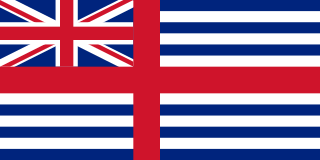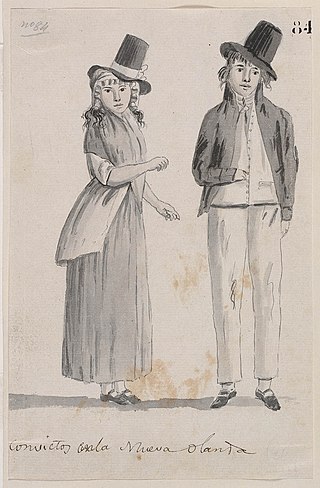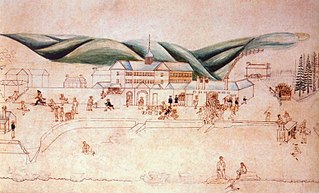Related Research Articles

Norfolk Island is an external territory of Australia located in the Pacific Ocean between New Zealand and New Caledonia, 1,412 kilometres (877 mi) directly east of Australia's Evans Head and about 900 kilometres (560 mi) from Lord Howe Island. Together with the neighbouring Phillip Island and Nepean Island, the three islands collectively form the Territory of Norfolk Island. At the 2021 census, it had 2,188 inhabitants living on a total area of about 35 km2 (14 sq mi). Its capital is Kingston.

The history of Norfolk Island dates back to the fourteenth or fifteenth century when it was settled by Polynesian seafarers.

Van Diemen's Land was the colonial name of the island of Tasmania used by the British during the European exploration and colonisation of Australia in the 19th century. The island was previously discovered and named by the Dutch in 1642. Explorer Abel Tasman discovered the island, working under the sponsorship of Anthony van Diemen, the Governor-General of the Dutch East Indies. The British retained the name when they established a settlement in 1803 before it became a separate colony in 1825. Its penal colonies became notorious destinations for the transportation of convicts due to the harsh environment, isolation and reputation for being inescapable.

A penal colony or exile colony is a settlement used to exile prisoners and separate them from the general population by placing them in a remote location, often an island or distant colonial territory. Although the term can be used to refer to a correctional facility located in a remote location, it is more commonly used to refer to communities of prisoners overseen by wardens or governors having absolute authority.

Penal transportation was the relocation of convicted criminals, or other persons regarded as undesirable, to a distant place, often a colony, for a specified term; later, specifically established penal colonies became their destination. While the prisoners may have been released once the sentences were served, they generally did not have the resources to return home.

The Macquarie Harbour Penal Station, a former British colonial penal settlement, established on Sarah Island, Macquarie Harbour, in the former colony of Van Diemen's Land, now Tasmania, operated between 1822 and 1833. The settlement housed male convicts, with a small number of women housed on a nearby island. During its 11 years of operation, the penal colony achieved a reputation as one of the harshest penal settlements in the Australian colonies. The former penal station is located on the eight-hectare (twenty-acre) Sarah Island that now operates as a historic site under the direction of the Tasmania Parks and Wildlife Service.
Alexander Maconochie was a Scottish naval officer, geographer and penal reformer.
William Hutchinson was a British convict who was transported to the Australian colonies, ultimately to become a successful public servant and businessman.

John Giles Price, was a colonial administrator in Australia. He served as the Civil Commandant of the convict settlement at Norfolk Island from August 1846 to January 1853, and later as Inspector-General of penal establishments in Victoria, during which he was "stoned to death" by angry and disgruntled prisoners.

Lieutenant Colonel James Thomas Morisset, penal administrator, was commandant of the second convict settlement at Norfolk Island, from 29 June 1829 to 1834.
Captain Joseph Wakefield, soldier and penal administrator, of the 39th Regiment was the acting commandant of the second convict settlement at Norfolk Island, from November 1828 to 29 June 1829.
Major Joseph Childs (1787–1870) was a British Royal Marines officer and penal administrator; he was commandant of the second convict settlement at Norfolk Island, from 7 February 1844 to August 1846.
Captain H. Day, soldier and penal administrator, was commandant of the second convict settlement at Norfolk Island, during its last days from September 1853 to May 1855.

Between 1788 and 1868 the British penal system transported about 162,000 convicts from Great Britain and Ireland to various penal colonies in Australia.

The postage stamps and postal history of Norfolk Island depended on Australia until 1947, when the island, an Australian territory since 1914, received its own stamps and postal autonomy.

Kingston and Arthurs Vale Historic Area (KAVHA) is an old settlement on the Kingston coastal plains, southern side of Norfolk Island, consisting of a large group of buildings from the British Empire's convict era (1788–1855), now considered to be of such cultural significance to Australia and to the World that the area has been formally inscribed onto both the Australian National Heritage List and UNESCO's World Heritage list as amongst:
" .. the best surviving examples of large-scale convict transportation and the colonial expansion of European powers through the presence and labour of convicts."
The Frederick escape was an 1834 incident in which the brig Frederick was hijacked by ten Australian convicts and used to abscond to Chile, where they lived freely for two years. Four of the convicts were later recaptured and returned to Australia, where they escaped the death sentence for piracy through a legal technicality.
Norfolk Islanders, also referred to as just Islanders, are the inhabitants or residents of Norfolk Island, an external territory of Australia. The Islanders have their own unique identity and are predominantly people of Pitcairn and English descent and to a lesser extent of Scottish and Irish.

The Cooking Pot Uprising or Cooking Pot Riot was an uprising of convicts led by William Westwood in the penal colony of Norfolk Island, Australia. It occurred on 1 July 1846 in response to the confiscation of convicts' cooking vessels under the orders of the Commandant of the penal settlement, Major Joseph Childs.
Norfolk Island twice served as a penal colony, from March 1788 to February 1814, and from 1825 to 1853. During both periods the government in the Colony of New South Wales transferred convicts that had been brought to Australia on to the island.
References
- Hazzard, Margaret, Punishment Short of Death: a history of the penal settlement at Norfolk Island, Melbourne, Hyland, 1984. ( ISBN 0-908090-64-1)